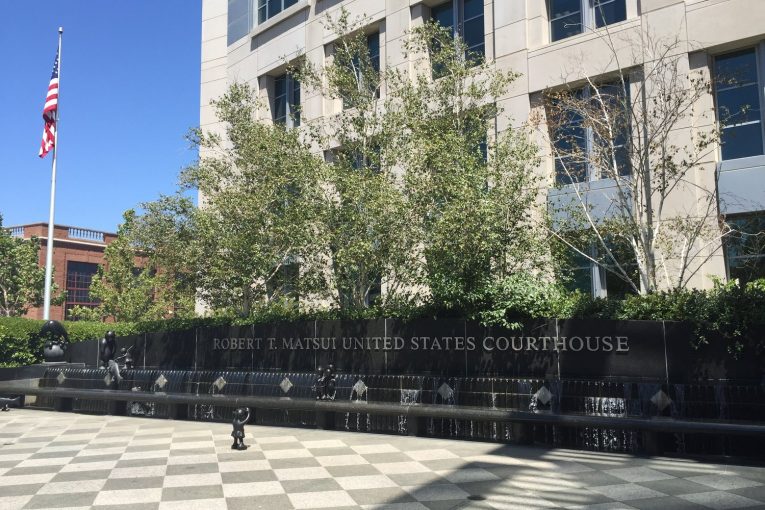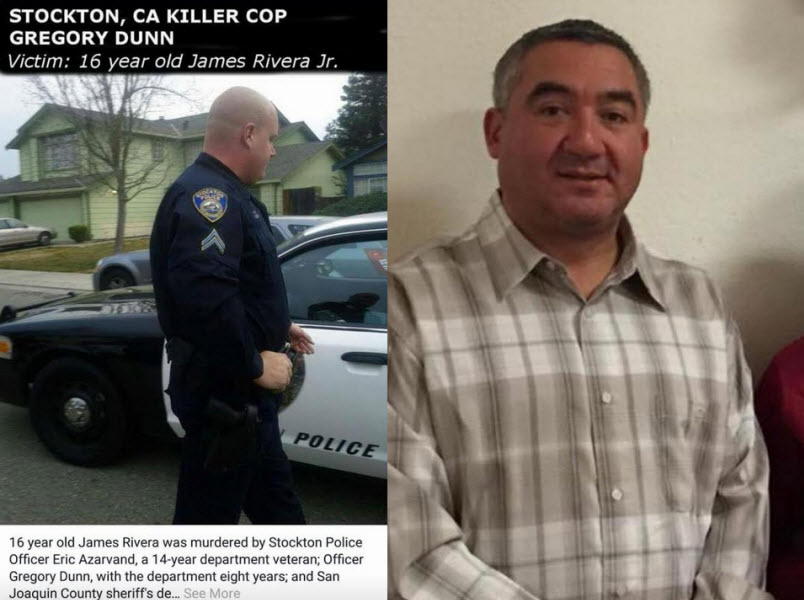

By Crescenzo Vellucci
Vanguard Capitol Bureau
SACRAMENTO – The judge in a federal civil rights trial here of two Stockton police officers who killed a 16-year-old special needs teen nearly 10 years ago declared a mistrial early Tuesday when the federal jury reported it was hopelessly deadlocked after only a few hours of deliberation.
The weeklong trial of former SPD officer Greg Dunn and current officer Eric Azarvand wrapped up late Friday afternoon, and the eight jurors deliberated for a few hours before retiring for a three-day weekend, returning Tuesday – but by mid-morning Tuesday they told the judge they were hung.
U.S. District Court Judge Carolyn Delaney declared a mistrial, and set Jan. 8, 2020, for a new trial.
Well-known civil rights attorney John Burris – who Friday said the officers panicked, lost their “wits” and shouldn’t have shot James Rivera, Jr., on July 22, 2010 – said Tuesday he wasn’t surprised, although his team had been hopeful.
“We believed we presented a sufficient enough case so the jury would rule on at least one officer, if not both,” said Burris, whose team was relentless in portraying officers who had killed Rivera as reckless.
Many witnesses, including bystanders, neighbors and – to some degree – even defense witnesses, agreed.
Burris said that the family was “upset at not getting a verdict,” and that it had been an “emotional” roller coaster for them to relive the death of Rivera Jr. after more than nine years looking for justice. “It was very emotional and now they have a big empty feeling,” explained Burris.
Rivera would have turned 17 the day after he was killed when police caught up with him driving a stolen van. Police pursued him, rammed the van and fired 29 rounds into a building where the van was wedged. No weapon was found, and Rivera never emerged from the van, until officers removed his body, riddled with nine rounds.
Burris said he didn’t know if the jury was hung in favor or opposed to the plaintiffs or defendants, and that while the judge could have given the “Allen instruction,” which encourages the jury to go back and work for a verdict, she did not.
San Joaquin County already settled for plaintiffs and parents Dionne Smith-Downs and James Rivera, Sr., for $300,000. The parents refused to settle with the city of Stockton.
It is unusual to have a civil rights case go to trial in an excessive force case, agreed Burris, who said about 90 percent of his cases like this settle. Still, he added, in some of his recent  cases that have gone to trial, one resulted in an $11.3 million verdict, another $2 million, while his firm lost a third case.
cases that have gone to trial, one resulted in an $11.3 million verdict, another $2 million, while his firm lost a third case.
The trial centered around whether officers were in real danger, and in reasonable fear for their lives.
Dunn insisted he was in danger. Other officers and bystanders disagreed. Dunn, and co-defendant Azarvand said they thought Rivera had a weapon, but the teenager was not armed.
Witnesses, including at least one police officer, said they didn’t see the van, wedged in the garage area of the triplex, appreciably move toward Dunn, and wasn’t a threat to Dunn, who was terminated from the Stockton police force for what SPD claims are unrelated reasons.
Burris focused on Dunn as the instigator of the shooting and death of Rivera.
“You can’t create conflict. You can’t place yourself in danger and then shoot your way out. It wasn’t ramming. The van was rocking. That’s not the basis to shoot. (And) shooting blindly 13 times (Dunn emptied his clip) into a space that he couldn’t see into…isn’t there some responsibility?” asked Burris of the jury.
“You can’t shoot because you panic and are afraid. You can’t execute someone,” added Burris, who criticized Dunn for not giving lawful verbal notice to Rivera that he would use force if Rivera – who may have been unconscious or injured from crashed into the residence – didn’t respond.
There was no standoff, Burris reminded the jury. Dunn hit Rivera’s stolen van twice, it crashed into the garage area of the triplex and about 15 seconds later Rivera died after a rain of bullets.
“No one said they would shoot. They only said to get out. There was no warning of force. Within seconds (of the warning) you heard shots…it shocks the conscience. Dunn might have been fearful but it’s not what a reasonable officer would have done,” said Burris.
“They chose to not take some time. They chose instead to take a boy’s life. James was surrounded and outnumbered. There was time to move back, he had time to move,” said Burris, laying the blame more on Dunn than any other officer.
“Officers shot because of what Dunn did, and only because he said he was trapped…that’s the basis for them to all shoot and kill,” charged Burris.
“If 29 shots doesn’t shock your conscience (a legal requirement for the plaintiffs’ win), nothing will. With proper warnings, (James) may have surrendered, but other officers responded to Dunn’s fear. Dunn panicked. He lost his wits. Firing of 29 shots is excessive force. Period,” Burris closed.
Plaintiff and defendant police practices experts disagreed with each other – one expert emphatically maintained Stockton police officers made a “tactical error” by shooting and killing Rivera, but another applauded the officers’ actions.
Another plaintiff attorney from Burris’ Oakland law office, Ben Nisenbaum, in his closing argument, used the words of the defense team’s own witnesses to show “this is evidence of a bad shoot. One shot was too much. This was unreasonable.”
Nisenbaum seized on the words of Craig Fries, founder of Precision Simulation, a forensic firm in Grass Valley, and a defense witness who provided a dramatic, animated reconstruction of the physical evidence at the scene – for the most part based on statements of Dunn and Azarvand.
“There is no evidence of significant (van) movement. Mr. Fries said zero to 15 inches, not five feet. Not enough to take a life or the use of lethal force,” he said, knowing that police usually need to claim and show they feared for their life to make the use of force legal.
For Dunn and Azarvand, that meant the threat of the van backing up and injuring them.
“But,” said Nisenbaum, “bumping is not ramming,” explaining to the jury that “rocking” is not moving and that the “suspect is not going to put it in reverse…because it was stuck in the garage.”
He used the testimony of another defense witness, Ronald Miller, a SWAT team instructor and the plaintiff’s police procedures expert Roger Clark to show “this was a panic shooting. (Dunn) lost self-control.”
“Miller and Clark agreed that if the van only moved slightly it was not enough to use lethal force. It should not have happened. The intervention was successful. The van was stopped. No shots were required. Each shot here was more gratuitous,” he said.
“Officer Dunn said he was concerned (about the van hitting him). He shouldn’t shoot somebody for that. He never had to shoot the boy at all. He should be in jail. They knew he was 16,” added Nisenbaum.
His arguments hit upon the same theme over and over again. That there was no need to shoot, the van was pinned in the residence, there were alternatives to killing Rivera other than shooting and Rivera was not a threat.
“You can’t take a life on that basis,” said Nisenbaum, who said that the shooting officers were “not on a clock…they knew (other) officers were coming. They had time to deliberate. They did not. They were deliberately indifferent. It was malicious.”
Bruce Kilday told the jury that, even for the defense, “this is has been a challenging case. A lawsuit can’t bring their (Dionne Smith-Downs and James Rivera, Sr.) son back. No one is happy about the outcome.”
He went on to list the “undisputed facts,” including that Rivera escaped from jail, reportedly burglarized a home, and participated in an armed car checking the day before.
He discounted the testimony of local residents, even the two neighbors who lived in the same triplex as the one that took the direct hit from the van when Dunn rear-ended it.
“Their central claim that the shooting was not reasonable, that the van was immobilized, the suspect trapped and that called for tactical repositioning is contrary to physical evidence,” he said, repeating that defense mantra that the van moved forward and backward and was a threat to the life of Dunn, who was caught in a “v” between his car, his car door and another car bumped to the left by the van when it plowed into the building.
Kilday argued that no one can now use “20/20 hindsight,” and stated that the two defendants believed what was “objectively reasonable at that time,” including that felt the “driver was not contained” and that to believe otherwise would be “foolhardy” by the defendants on the scene.
“The threat had not come to a conclusion; there was no time for decompressing,” as Clark, the plaintiff expert witness recommended. “Tactical repositioning would not have worked,” noted Kilday.
“(Expert witness) Clark said he was agnostic about movement of the van….Dunn didn’t have luxury of being agnostic,” said Kilday, and asked the jury to find his officers not guilty.
